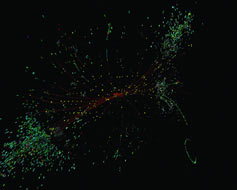
Handy Links
SLAC News Center
SLAC Today
- Subscribe
- Archives: Feb 2006-May 20, 2011
- Archives: May 23, 2011 and later
- Submit Feedback or Story Ideas
- About SLAC Today
SLAC News
Lab News
- Interactions
- Lightsources.org
- ILC NewsLine
- Int'l Science Grid This Week
- Fermilab Today
- Berkeley Lab News
- @brookhaven TODAY
- DOE Pulse
- CERN Courier
- DESY inForm
- US / LHC
SLAC Links
- Emergency
- Safety
- Policy Repository
- Site Entry Form

- Site Maps
- M & O Review
- Computing Status & Calendar
- SLAC Colloquium
- SLACspeak
- SLACspace
- SLAC Logo
- Café Menu
- Flea Market
- Web E-mail
- Marguerite Shuttle
- Discount Commuter Passes
-
Award Reporting Form
- SPIRES
- SciDoc
- Activity Groups
- Library
Stanford
Around the Bay
A Shotgun Approach to New Particles
 At the International Linear Collider, electrons will shoot out from one end of the accelerator at
nearly the speed of light and collide with a beam of anti-electrons, or positrons, traveling at the
same speed. The expectation is that the energies of the collisions will be great enough to produce
particles that could help further our understanding of the universe.
At the International Linear Collider, electrons will shoot out from one end of the accelerator at
nearly the speed of light and collide with a beam of anti-electrons, or positrons, traveling at the
same speed. The expectation is that the energies of the collisions will be great enough to produce
particles that could help further our understanding of the universe.
The ILC's latest design, counting the accelerator, service tunnels and elliptical damping rings, proposes a tunnel complex of nearly 85 km. The current largest accelerator, the Large Hadron Collider in Geneva, Switzerland, forms a 27 km ring.
Both the electrons and positrons will be accelerated to an energy of 250 GeV (giga or billion electron volts). This is a very large energy: an electron at rest has a mass about 1/2000 that of a proton; an accelerated electron at the ILC will have a relativistic mass of 250 protons.
High energies mean high possibility of unusual particles bursting from the collisions. Einstein’s theory of relativity says matter and energy are different forms of the same thing and relates them with the famous equation E=mc2. Simply put, the energy from an electron–positron collision can turn into matter. Most importantly, energies involved at the ILC are great enough to produce new particles—including the Higgs, which is theorized to give mass to all other particles.
Special relativity dictates that nothing can go faster than the speed of light. At the ILC, electrons will reach 99.999 999 999 8% of that limit. If the electron beam were to race a beam of light from the Earth to the moon, the light would beat it by 4 mm.
The size of electrons and positrons makes it exceptionally tricky to direct their beams to collide. For a sense of how hard it is to make collisions happen at the ILC, consider shotguns. One round fires about 300 pieces of shot which spreads to 1 meter, with each pellet measuring about 1 mm across. Two shotguns would have to be fired, on average, 35 times before 2 pellets collided. Electrons are a lot smaller than shotgun shot.
If shotguns were to fire electrons instead, then two shotguns firing once a second with 300 electrons per round would create a collision every 3 x 1035 seconds. This is a quintillion (1018) times the lifetime of the universe. Experimental physicists are patient, but not that patient.
To speed things up, ILC scientists plan to do three things: they will increase the number of particles fired in each pulse, the frequency of pulses, and shrink the beam spread. They will fire 20 billion electrons at 20 billion positrons 14,000 times per second. This brings the collision rate up to one every 160 million years. Dinosaurs went extinct 65 million years ago. Again, experimental physicists are patient, but not that patient.
Finally, they will narrow the beam spread to 6 x 10-9m by 650 x 10-9m wide—an area as big as 21 water molecules high and 2300 wide. With such a small spread, electrons and positrons will collide 3 x 1014 times more often, or four times each minute. Physicists need to analyze millions of such collisions, so experiments will take several years. And physicists are that patient.
How hard is it to aim such tiny beams at each other so that they collide?
The final aim in the ILC is taken at a distance of 4 m from the collision point. The aim required to get the beams to collide is like placing a rifleman in Florida and one in Alaska, and having their bullets collide over Boise, Idaho.
Marksmen may have highly specialized telescopic sights, but the ILC’s precision feedback system will do an even better job. The accelerator will pulse 5 times per second. Each pulse carries about 3000 bunches of particles spaced by 300 billionths of a second. The first few bunches of each pulse will likely miss each other, but by measuring by how much they missed, feedback systems will adjust the aim so the rest of the bunches in each pulse will collide. This makes the problem easier—but hardly easy.
Image: Simulated event illustrating the associated production of a Higgs particle and a Z boson at a linear collider. (Click image for larger version. Image courtesy of Norman Graf.)
—Krista Zala
SLAC Today, July 6, 2006